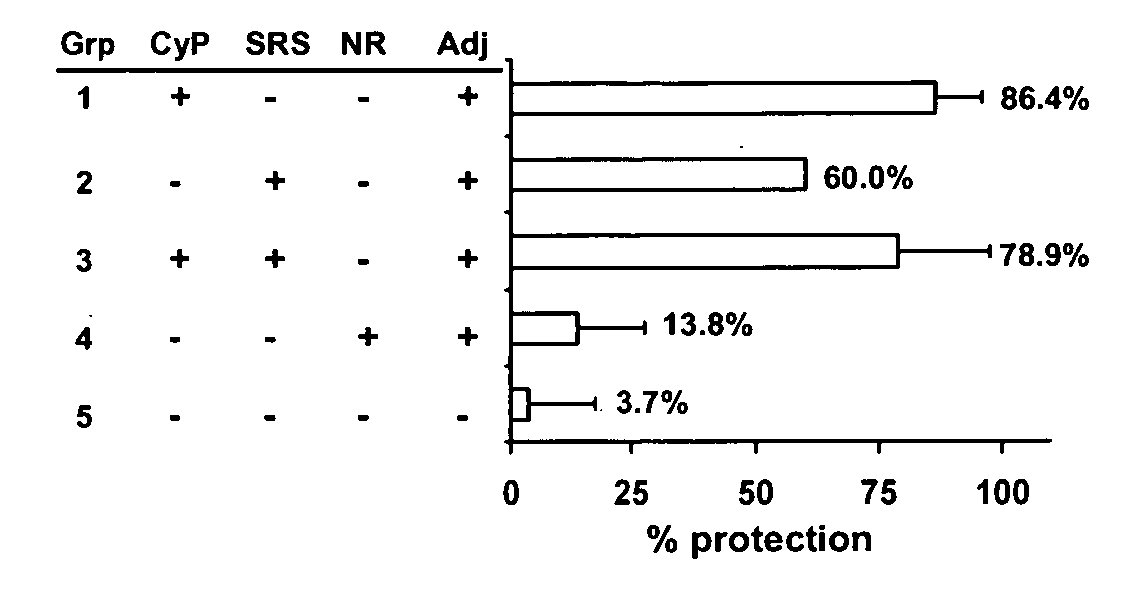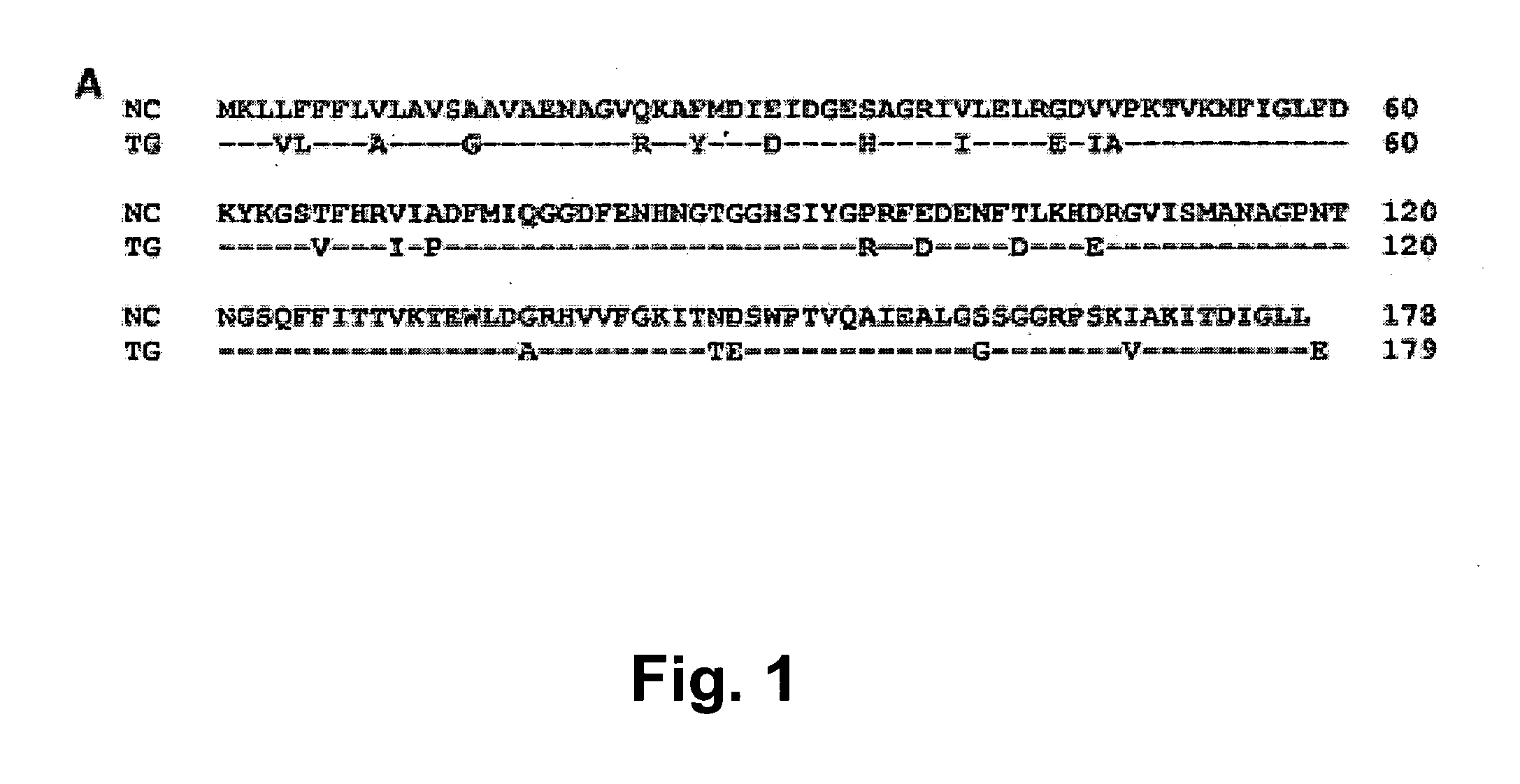Novel Neospora caninum Vaccine
a vaccine and neospora technology, applied in the field of new neospora caninum vaccine, can solve the problems of no effective chemo- or immuno-prophylactic treatment, vaccine could only achieve partial protection, etc., to prevent or reduce the severity of infections, and reduce the severity of n
- Summary
- Abstract
- Description
- Claims
- Application Information
AI Technical Summary
Benefits of technology
Problems solved by technology
Method used
Image
Examples
example 1
N. Caninum Tachyzoite and N. Caninum Whole Cell Tachyzoite Lysate Preparation
[0075]N. caninum tachyzoites and N. caninum whole cell tachyzoite lysate (NcAg) were prepared as described elsewhere (Tuo et al., supra). Briefly, N. caninum (NC1 isolate) tachyzoites were cultured on the African green monkey kidney cells (CV1, ATCC CCL-70) in RPMI 1640 medium supplemented with 2% fetal calf serum and 50 μg / ml gentamicin at 37° C. in a 95% air and 5% CO2 atmosphere. N. caninum tachyzoite-infected host cells were collected, passed through 20- and 27-gauge needles, and pelleted by centrifugation at 1,000 g for 20 min at 4° C. Tachyzoites were then purified by centrifugation over a 40% Percoll gradient at 2,000 g for 30 min at 4° C. To prepare live tachyzoites for challenge infection, the purified tachyzoite pellet was washed once in RPMI 1640, the suspension was adjusted to appropriate concentrations and placed on ice until use. To prepare NcAg, the tachyzoite pellet was resuspended in PBS (p...
example 2
NcAg-Induced IFNγ Production in Mouse Splenocytes
[0076]Mice were euthanized by CO2 and cervical dislocation. Spleens were aseptically collected and splenocytes prepared. Briefly, the spleen was forced through a metal mesh in RPMI 1640 with a syringe plunger and the cell suspension was pipeted up and down to break up cell clumps prior to isolation using Histopaque-1077 (Sigma). Isolated splenocytes were washed, enumerated and adjusted to 5×106 cells per ml in complete medium. Cells (106) were then added to each well of the 24 well plates and treated with increasing concentrations of NcAg (0, 0.3, 3, or 9 μg / ml) or CsA (0, 1, 10, or 100 nM) in a total volume of 2 ml RPMI 1640 medium supplemented with 10% fetal calf serum and 50 ug / ml getamicin (complete medium). Plates were incubated at 37° C. with a 5% CO2 and 95% air atmosphere for 48 hr. Supernatant was collected, centrifuged and stored at −20° C. until assayed.
[0077]IFNγ production by splenocytes was highly stimulated by NcAg in a...
example 3
Preparation of Recombinant NcCyP and NcSRS2
[0079]Nine EST clones of the NcCyP gene are found in Genbank. Only partial sequences are available for eight of the NcCyP clones; the partial sequences of all eight clones are identical. Only clone CF422590 has the full length coding region (Tuo et al., supra). This clone (dbEST Id: 19687522, CF422590, 621 bp) was kindly provided by Dr. Sandy Clifton (Washington University School of Medicine, St. Louis, Mo.) and used as the DNA template for PCR amplification and cloning. The open reading frame (ORF) encoding N. caninum cyclophilin (NcCyP) was polymerase chain reaction (PCR)-amplified and cloned into the expression vector pET28 (Novagen, Madison Wis.). In order to facilitate the cloning and downstream recombinant protein purification processes, recognition sites for restriction enzymes Ndel (CATATG) and EcoRI (GAATTC) were incorporated into the forward (5′-GCATATGMGCTCCTGTTC TTCTTCCTC-3′; SEQ ID NO:3) and reverse (5′-AGMTTCTTACAACAAACCM TGTC...
PUM
| Property | Measurement | Unit |
|---|---|---|
| Time | aaaaa | aaaaa |
| Immunogenicity | aaaaa | aaaaa |
Abstract
Description
Claims
Application Information
 Login to View More
Login to View More - R&D
- Intellectual Property
- Life Sciences
- Materials
- Tech Scout
- Unparalleled Data Quality
- Higher Quality Content
- 60% Fewer Hallucinations
Browse by: Latest US Patents, China's latest patents, Technical Efficacy Thesaurus, Application Domain, Technology Topic, Popular Technical Reports.
© 2025 PatSnap. All rights reserved.Legal|Privacy policy|Modern Slavery Act Transparency Statement|Sitemap|About US| Contact US: help@patsnap.com



